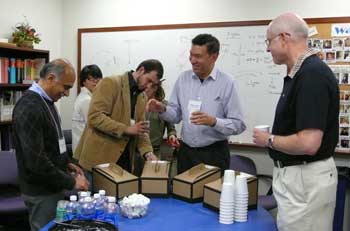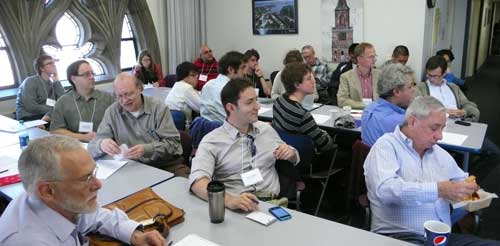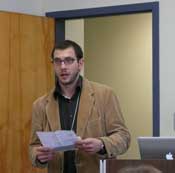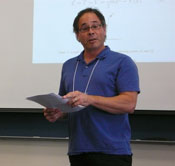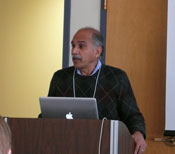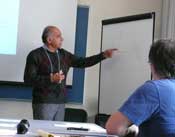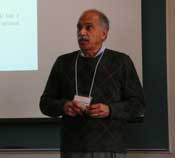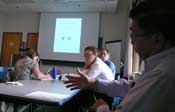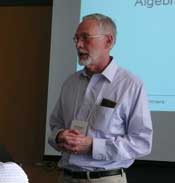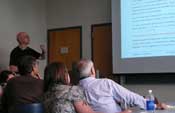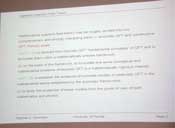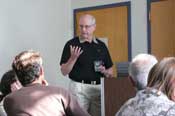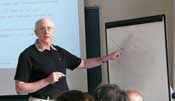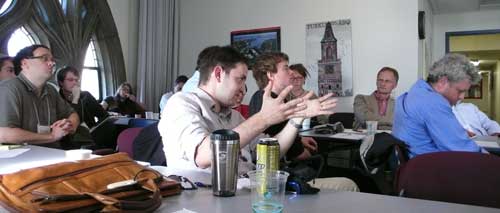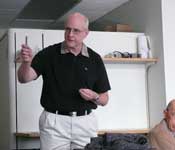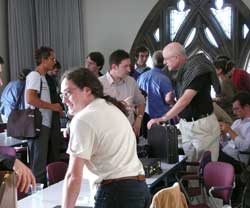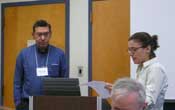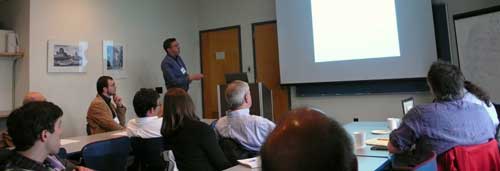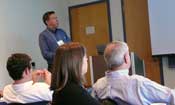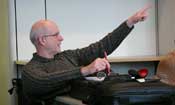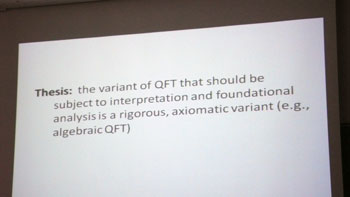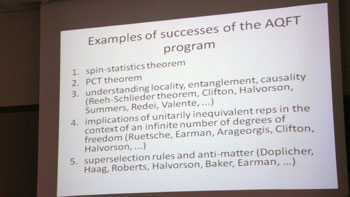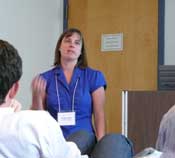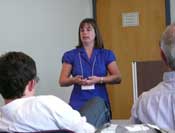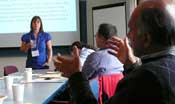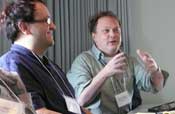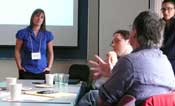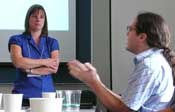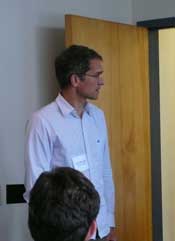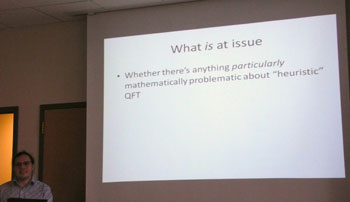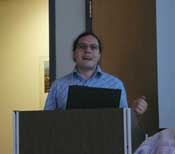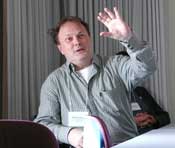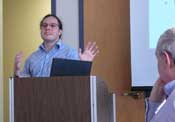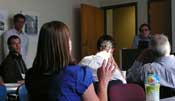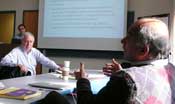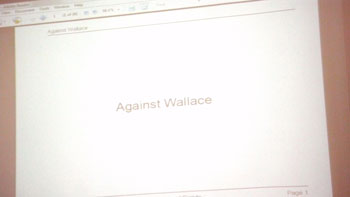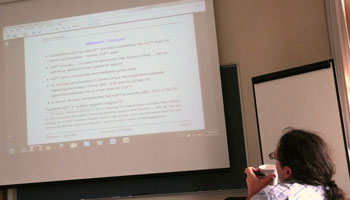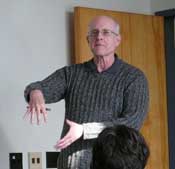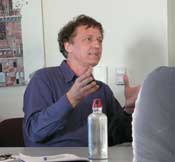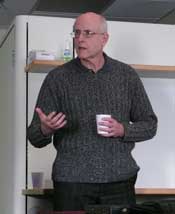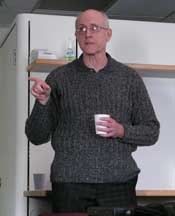
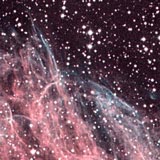
![]()
home
::: about
::: news
::: links
::: giving
::: contact
![]()
events
::: calendar
::: lunchtime
::: annual
lecture series
::: conferences
![]()
people
::: visiting fellows
::: postdoc fellows
::: resident fellows
::: associates
![]()
joining
::: visiting fellowships
::: postdoc fellowships
::: senior fellowships
::: resident fellowships
::: associateships
![]()
being here
::: visiting
::: the last donut
::: photo album
|
Quantum Field Theory Workshop The title "Quantum Field Theory Workshop" does not convey the quite pointed intent of the organizers. This is not a workshop on quantum field theory at some level of vague generality. It is specifically about the methods used to do quantum field theory. Which are the right ones? That is an awkward question to ask the theorists for there are at least two communities vying for the credit of having found the right way. However it is even more awkward than that for a reason that strikes close to home. Those in our community of philosophy of science who think about quantum field theory must also decide which methods they will use. Our community is taking sides. Philosophers of physics in the room have their own horses in the race.
These are the questions I had as we settled in for the start of the workshop. As organizers, we never know until the hour is struck just how many will walk through the door. We'd guessed the number from voluntary registrations and set up the tables and chairs accordingly. We had guessed almost exactly right, I noted with some professional pride. There was barely an empty chair in the room. Quantum theory? Quantum field theory? Here's a little background. Philosophers of science who don't specialize in philosophy of physics usually only encounter "ordinary, non-relativistic quantum theory." This is the theory of Schroedinger's cat, measurement collapse, entangled states and the infamous "eee pee arr" --EPR. This theory is fine for simpler problems. But once one gets into serious particle physics and the standard model, it is not enough. One needs something richer to capture all that happens at the subatomic level, such as the creation and annihilation of particles.
The overwhelming majority of work undertaken by field theorists is in an "intuitive" or "heuristic" tradition. It has supplied us with the long list of experimental successes attached to particle physics. It has problems. In order to achieve its results, it uses methods that are mathematically dubious. Most notoriously, even in quite simple problems, infinities appear that cannot correspond with reality. These infinities are subtracted away in the procedure of "renormalization" to leave empirical predictions of startling accuracy. The procedure was initially regarded with suspicion, but later improvements on the procedure have left theorists with the confidence to assure us that it is really quite fine... really. Mathematically oriented theorists have responded to the imprecise mathematics of field theory with their own approach. It is loosely labeled "algebraic quantum field theory" and proceeds cautiously, but with rock solid mathematical foundations. It comes with penalties. The treatments are considerably more burdensome than the corresponding heuristic treatments; and it is perpetually playing catch up, providing few if any realistic models.
There are just two speakers for the afternoon, each given ample time to lay out whatever they have to lay out. They are the champions drawn from two communities of theorists. Would the battle be joined? Would they collapse into endlessly guarded polity? Or would they just deliver their standard talk-of-the-month? Giovanni Valente and Bob Batterman comprised the conference program committee and take credit for it. Giovanni made the opening announcements and Bob introduced the first speaker.
The famed Richard Feynman had brought the approach to life over 50 years ago with his path integral formulation of quantum theory. When a classical particle passes to its future state, it traces out just one path in space-time. When a quantum particle passes to its future state, it does it by following every possible path through space-time. Shankar's presentation consisted of the display of a series of triumphs. Bosonic coherent state path integrals, fermonic coherent state path integrals, SU(2) path integrals for spin S, Chern Simons theory, fractional quantum hall effect, knots, renormalization of quantum field theory and Fermi liquids, topological super conductors... I dutifully log their names here. Novice that I am, the dense slides of mathematics left me impressed but no more informed on each topic than when I sat down. Mathematical precision? That entered only once. There is a long standing difficulty in Feynman's path integral approach. The particle follows all paths, so the final result is achieved by summing over all paths. Exactly how to take this sum is the problem. The standard textbook treatments describe a quantity that makes no mathematical sense if taken literally. It does something like ask you to count up how many lines segments stacked up make a square. But if you duplicate the textbooks' step-wise calculations exactly you will get good results. This, Shankar mused, will likely be the topic of further discussion.
His opposite number this afternoon was Stephen Summers. He is responsible for many of the theorems that mathematically inclined philosophers of physics call upon from recent work. He was introduced by John Earman, who noted with puzzlement and even a touch of admiration that Summers's degree is not in mathematics. Summers began by squarely addressing the central issue of the workshop. His summary was succinct and memorable. It may well be the "take home" lesson of the workshop: There is no debate in physics between heuristic quantum field theory and mathematical quantum field theory! They don't talk to each other. The debate exists only among a few philosophers of physics. Summers has already had sufficient contact with philosophers of physics to know what would be an appropriate talk, he assured us. The talk he would give would be addressed to philosophers of physics with a mathematical bent. In retrospect, I did not then realize quite what he meant. The talk began in a familiar mode. He projected elementary notions that I knew presaged increasing levels of technicality until, inevitably, I would be lost. I settled into my seat. The development was earnest, but often reduced to reading the text from the projector slides, pointing at the words as he read them with his laser pointer. The development had been running for a while when I began to notice a change in Summers's demeanor. He was more excited and becoming more pointed. He had been reading the philosophy of physics literature in quantum field theory, and he needed to make corrections to it. He projected a paragraph that quoted from one of his own papers, published in a philosophy of physics journal. He apologized for reading from it, but he wanted the philosophers of physics present to have no excuse for not knowing its content.
This was puzzling. Summers clearly had a definite target. But the target was not named. I found later that I was not alone in the mental search. Who was his target? At first, his complaints seemed broadly focused. He'd admonished the philosophical literature for expressing doubts about the use of the thermodynamic limit in statistical physics. At that moment, I found myself paying much closer attention. My latest paper includes a long discussion of the thermodynamic limit and it manages to find fault in just about every literature that uses it. I was watching Summers closely as he spoke. He seemed to be looking straight at me. Could he know of the paper? How could he know of the paper? It is posted on my website and philsci-archive, but is not in a journal yet. I knew for the first time what it must be like to stand in a police line-up. He cannot mean me, I was telling myself. The Mona Lisa's eyes follow you where ever you stand. It is an illusion. The moment passed, and it was clear that his principal ire was focused elsewhere. Someone working with algebraic quantum field theory? Someone critical of it? Both? Debates in philosophy of science are not so anonymous. Our targets are cheerfully named and, in my case, I'm likely to put up a photo. (I do try to find a flattering one. No cheap shots.) There was much corrective work to be done, it seemed, and he set himself to the task. After he had been speaking for an hour, he paused. It was a procedural break, akin to a "point of order" in a meeting run under Robert's rules. He had been told that he should speak for an hour and have half an hour of questions, but that he need not rigidly follow this. He was availing himself of this last option, he announced. Again, the mathematical theorists do not compete when it comes to predictions. However every now and again, they do manage to make a prediction. He then quickly sketched the familiar EPR-Bell set up but now with quantum field operators. The Bell inequalities are maximally violated in this set up, he declared, only with quantities that are representations of the Pauli spin matrices. That is a prediction! The talk ended. There were hasty questions and, in one case, hastier answers. We had two talks that had gone in directions I would not have predicted. What will the next day bring?
Duncan had always assured me that this is not really how the theory is. Once you know how to approach it, you see it has to be the way it is. However somehow over all the years I've known him, I've never heard him lay it out.
Shortly after, he arrived at renormalization, the bugbear of quantum field theory. He enthused over the renormalization group methods introduced in the 1970s by Ken Wilson and others: "they revolutionized the field." The key idea of renormalization, as he affirmed when I quizzed him in question time, is a physical hypothesis. What happens at very high energies, or equivalently, at very short length scales, proves irrelevant to processes we predict at lower energies. The infinities enter because our theory is false at these high energies and we can discard them without empirical penalty. The new methods enable us to see most clearly how our low energy physics is independent of what happens at these higher energies. There are many ways we can cut off the infinities; these methods show us that they all produce the same results. What of the troublesome path integrals of Shankar's talk? We must tame them by replacing the continuum of space and time by a discrete lattice of points. That was all it takes to make the integrals well defined. "We must tame them..."?? The "must" was too strong and Duncan corrected himself to an "it is sufficient" after an interjection by Stephen Summers. The use of a lattice also forces giving up exact translation and rotational invariance in space, Summers pressed. There was a sense of quiet but diligent oversight.
It was now clear to me that physicists really do have trouble stating philosophical theses clearly. I don't expect it. It is not their job. It is the job of philosophers. Fraser began by doing just that. She stated simply and clearly just what her claim is. The mathematical algebraic quantum field theory is the right subject for the foundational and interpretational analysis of philosophers. The rest of the talk will defend that claim. She was taught well. The defense was elaborate, with many parts. On the one side, there are many interpretive successes in the mathematical tradition. A slide listed them conveniently. But the deepest reason seemed to me the most obvious and most powerful. If one wants to know what a theory says is in the world and what its deepest fundamentals are, we are much better off looking at a formulation of the theory that is mathematically precise. Then there is one less ambiguity to trouble us. In 1955, Haag proved a celebrated theorem, foundational to this literature. It showed that, given certain assumptions, the rigorized quantum field theory has no place for particles that interact. That may seem an abstruse worry until it is translated into mundane terms. It means that protons cannot attract electrons electrically. That is unsustainable. The project is to decide which from the list of assumptions is to be given up. It is a precise analysis, driven by logic and mathematics. All this would be impressive to someone who stumbled by. But this room was filled with experts who know a lot and would need more convincing. Fraser knew that she had to tackle squarely one of the more awkward deficiencies of the algebraic approach. It has no realistic models. There is no elaborated treatment of the standard model of particle physics, with its weak and strong interactions. Theorists with a practical bent find that troublesome. It is as if we purchased the most perfect of musical instruments, yet we are unable to figure out how to play a tune on it. Fraser's response was to distinguish two activities: theoretical and empirical. Heuristic quantum field theory shines at making predictions that can be tested. That is where renormalization comes in. The algebraic approach, however, is where we best get theoretical results. All this was enormously interesting. I could see in each claim and more not mentioned above the seeds of energetic discussions. Unlike the previous speakers, Fraser did not run past her suggested hour. There remained a half hour for questions. What followed was one of the best question periods I can recall. Each of Fraser's seeds sprouted. Distinctions in philosophy, even the simplest ones, are hard to maintain. That one can assign such different roles to the heuristic and algebraic approaches--empirical and theoretical--was the target of special interest. It was pursued in different forms by many: Wayne Myrvold, Michel Janssen and more. For me the most telling form was to ask after the discarding of quantum field theory in the high energy domain, as required by renormalization. Isn't that interpretive, ontological? How can that be fenced off as a merely empirical issue? I had entered the workshop with the secret prejudice that there is no single, right method for philosophers to use. This discussion was convincing me of that. We need to be unapologetic opportunists and use whichever methods happen to be most promising for a particular problem. No prior decision between algebraic or heuristic methods is sustainable.
Wallace's opening thoughts promised otherwise, initially. He made clear that what was not at issue was the viability of algebraic methods and that they are sometimes useful. He later illustrated that use with the recent literature on inequivalent representations of the commutation relations. "Let a thousand flowers bloom," he remarked at one point in a conciliatory tone. It sounded innocent, but I've heard too many talks to be in doubt about his strategy. Disarm your opponent by conceding every response they can make in advance. Only then do you attack a disarmed opponent. Then, as I expected, the discussion became more pointed and less forgiving. What is at issue is whether there is anything particularly mathematically problematic about heuristic quantum field theory. There once was a problem with the mathematical coherence of quantum field theory. That was in the 1940s when the renormalization of quantum field theories was first explored and the troubling infinities first appeared. With the emergence of renormalization group methods in the 1970s, however, the problem was solved. Heuristic quantum field theory, he assured us, is now mathematically no worse than astrophysics, chemistry or laser optics. So, what of algebraic quantum field theory? It arose shortly after the early problems of renormalization were identified as a part of an attempt to solve the problem. It was no longer needed for that purpose. This superfluity seemed to be the crux of Wallace's case. The algebraic approach is just no longer needed. The remainder of Wallace's exposition reflected on the ways that philosophers of physics have engaged with foundational problems in physics. Through a series of examples, he noted that the philosophers of physics tend to pick up the minority method in physics, just as they did in this case. Question time was moderated by Hans Halvorson, himself a central figure among philosophers who work on the algebraic approach. It was slow to start so Halvorson stepped in to keep things alive. That intervention opened the most interesting discussion. Wallace had argued that philosophers of physics ought to work with the heuristic approach since it had the only real chance of being true. For it was the theory that had realistic models, made predictions and thus could be tested against experience. Halvorson had the opposite end of the debate. If one wants to work with a theory that can be true, we should pick the theory that is consistent; and that is the algebraic theory, for, if nothing else, consistency is assured by its mathematical rigor. Wallace objected and discussion took off, bouncing around the room.
The final talk was Stephen Summers'. We were anticipating it with some trepidation. It was clear from his talk on Friday that he took a dim view of at least some of the philosophers. His few interjections during the other talks had been tart, betraying impatience with what he was hearing. Here was someone who knew he was right, for mathematical proof gives certainty, and did not see the need to offer the usual niceties to those misguided enough to disagree. What would happen now? The talk began with a few reflections on what he might have spoken about. Then he confessed that he had decided not to be a "good boy" and give an innocuous talk. The unannounced title of his talk was flashed on the screen "Against Wallace" and his target became clear. David Wallace had written a paper in the recent 2011 Studies in History and Philosophy of Modern Physics, "Taking Particle Physics Seriously: A Critique of the Algebraic Approach to Quantum Field Theory." It had concluded provocatively that algebraic quantum field theory was a failed research program. That was an accusation too public and too unfavorable to be left unanswered. Wallace's paper was the target. The next screen showed a list of Wallace's errors in the paper. They were specific and detailed, including quotes from the paper. The second was that the quantum fields of the algebraic approach are defined on arbitrary small regions. This had been the error revealed in the work of some unnamed philosopher in Summers' first talk. The offending party was now named. Then came a moment of drama. Wallace had his head buried in his computer and he spoke up. "It's not a quote! I have the paper here in front of me." He was referring to the second item in Summers's list, which read: AQFT "crucially ... includes the assumption that quantum fields ... can be defined on arbitrarily small spacetime regions". For the first time at the workshop, Summers was stalled. He wanted to dispute the claim, but paused. Perhaps he doubted he could find the quote; or perhaps he saw there was no time to do it. He looked around the room and asked us all if he should continue. I thought it was a real query. It somehow seemed entirely possible that he would turn on his heels and stalk out if he did not hear support. Someone called out that he should continue. The moment passed and the talk continued. The talk proceeded with point-by-point explanations of why he disagreed with Wallace's claims, conceding very little. It then turned to a lengthy overview of the accomplishments of "constructive quantum field theory." This is work by algebraic theorists aimed at constructing more realistic models of quantum fields. It drove towards the memorable quote from his colleague Klaus Fredenhagen, "Anything they can do, we can do now too." However Summers was clear that the "now" had to be read in the perspective of the long time horizons of the mathematician. How long are those horizons? Fermat's theorem had only now been proven some 350 years after it was conjectured.
Question time was now opened. Wallace had sat silently, but for one outburst, while Summers had assailed him. This had given him time to reflect on how best to respond. He chose well. He read the offending quote in full to make clear that it was taken out of context in a way that altered its import. He then thanked Summers for the mathematics, which he had enjoyed, but regretted that Summers had chosen to diminish it and himself by its "unscholarly wrapper." Summers seemed to sense that this was a conciliatory gesture. It was an offer of a truce, rather than a surrender. To our communal relief, the truce was accepted. The questions that followed were interesting and the discussion moved well, but we were all tired after a long day. There was much driving the enthusiasm with which we accepted Halvorson's invitation to thank Giovanni and Bob for their efforts in organizing the conference. John D. Norton |
